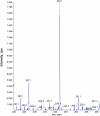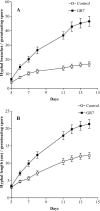Strigolactones stimulate arbuscular mycorrhizal fungi by activating mitochondria
- PMID: 16787107
- PMCID: PMC1481526
- DOI: 10.1371/journal.pbio.0040226
Strigolactones stimulate arbuscular mycorrhizal fungi by activating mitochondria
Abstract
The association of arbuscular mycorrhizal (AM) fungi with plant roots is the oldest and ecologically most important symbiotic relationship between higher plants and microorganisms, yet the mechanism by which these fungi detect the presence of a plant host is poorly understood. Previous studies have shown that roots secrete a branching factor (BF) that strongly stimulates branching of hyphae during germination of the spores of AM fungi. In the BF of Lotus, a strigolactone was found to be the active molecule. Strigolactones are known as germination stimulants of the parasitic plants Striga and Orobanche. In this paper, we show that the BF of a monocotyledonous plant, Sorghum, also contains a strigolactone. Strigolactones strongly and rapidly stimulated cell proliferation of the AM fungus Gigaspora rosea at concentrations as low as 10(-13) M. This effect was not found with other sesquiterperne lactones known as germination stimulants of parasitic weeds. Within 1 h of treatment, the density of mitochondria in the fungal cells increased, and their shape and movement changed dramatically. Strigolactones stimulated spore germination of two other phylogenetically distant AM fungi, Glomus intraradices and Gl. claroideum. This was also associated with a rapid increase of mitochondrial density and respiration as shown with Gl. intraradices. We conclude that strigolactones are important rhizospheric plant signals involved in stimulating both the pre-symbiotic growth of AM fungi and the germination of parasitic plants.
Figures






Comment in
-
A chemical facilitator of plant-fungus communication.PLoS Biol. 2006 Jul;4(7):e241. doi: 10.1371/journal.pbio.0040241. Epub 2006 Jun 27. PLoS Biol. 2006. PMID: 20076609 Free PMC article. No abstract available.
References
-
- Dakora FD, Phillips DA. Root exudates as mediators of mineral acquisition in low-nutrient environments. Plant Soil. 2002;245:35–47.
-
- Bais HP, Park SW, Weir TL, Callaway RM, Vivanco JM. How plants communicate using the underground information superhighway. Tr Plant Sci. 2004;9:26–32. - PubMed
-
- van West P, Appiah AA, Gow NAR. Advances in research on oomycete root pathogens. Physiol Mol Plant Pathol. 2003;62:99–113.
-
- Bais HP, Prithiviraj B, Jha AK, Ausubel FM, Vivanco JM. Mediation of pathogen resistance by exudation of antimicrobials from roots. Nature. 2005;434:217–221. - PubMed
MeSH terms
Substances
LinkOut - more resources
Full Text Sources
Other Literature Sources
Miscellaneous

